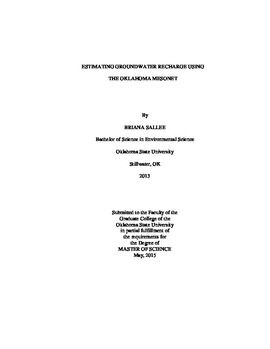| dc.description.abstract | Groundwater supplies a large portion of water used in Oklahoma, and accurate and current information regarding groundwater recharge rates is essential for long-term, sustainable groundwater management. The Oklahoma Mesonet has provided soil moisture data at 120 monitoring stations for nearly two decades. Using these data in conjunction with site-specific soil hydraulic properties, we have estimated potential groundwater recharge, hereafter called drainage, at a depth of 60 cm for 78 Mesonet sites. Our working hypothesis is that these drainage rates are greater than or equal to the amount of groundwater recharge at each location. Calculated mean drainage rates from 1996-2012 ranged from 4 mm yr-1 at Hinton to 275 mm yr-1 at Bristow, with a state-wide median of 61 mm yr-1. To clarify the relationship between these site-specific drainage rates and actual, independently-estimated groundwater recharge rates, three techniques were used. For site-specific recharge estimates, the unsaturated zone chloride mass balance method (CMBuz) was applied to soil cores taken at eight Mesonet sites in western Oklahoma. Secondly, HYDRUS 1-D was used to model the effects of root water uptake below 60 cm at these eight sites. Third, to compare aquifer-wide Mesonet drainage rates to independently-estimated regional recharge rates, the saturated zone chloride mass balance method (CMBsz) was applied to groundwater chloride data. CMBuz analysis estimated recharge rates ranging from 0.12 mm yr-1 at Boise City to 2.5 mm yr-1 at Arnett, values much lower than Mesonet-based drainage rates. Modeled water flux at the 60-cm depth was generally higher than Mesonet-based drainage, ranging from 7.5 mm yr-1 at Goodwell to 145 mm yr-1 at Fort Cobb. Simulations also showed that a significant portion of water passing the 60-cm depth may be lost to root water uptake before reaching the 3-m depth. CMBsz calculations yielded recharge rates ranging from 4.8 to 25mm yr-1 for five aquifers in western and central Oklahoma, giving values similar to or less than median Mesonet-based drainage rates. Overall, Mesonet-based drainage estimates seem to provide a reasonable upper limit for recharge rates at a regional scale, but may substantially overestimate recharge at sites with deep soil in western Oklahoma. | |
